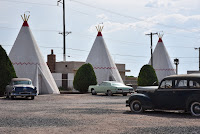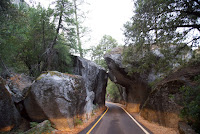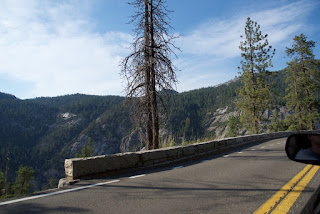Our family of six embarked on an epic (yes, I believe I CAN use that word!) 7000-mile road trip/vacation this summer, traveling from Alabama to Washington state, taking the southern route through Tennessee, Arkansas, Oklahoma, Texas, New Mexico and Arizona then making our way north through California and Oregon. I’m feeling a bit claustrophobic just remembering all the hours in the car…!

Dauma Family Road Trip 2015 Santa Fe ~ Grand Canyon ~ Beaumont/Los Angeles, CA ~ Yosemite ~ San Francisco ~ Portland/Vancouver ~ Soap Lake, WA ~ Seattle
I could have titled this blog post “The Chronicles of Stinky Feet” or “The iPad Password Mystery.” Let me tell you, traveling with four kids for thousands of miles is not for the faint of heart. For the love of Febreze and Steve Jobs.
Lesson #1:
The best laid plans DO often go awry.
My first meltdown (it was minor) was at 9:30 PM on day six, when we pulled up to the cabin we’d rented just outside the entrance to Yosemite and realized that the owners had never texted us with the security code. And we had no cell signal. We drove a bit and got a signal, but they didn’t reply to our texts or calls. So after an hour, we said goodbye to our perfect little cabin – complete with a bear carved from a tree on the front porch – and headed to the nearest town with a hotel room that would fit our family of six. Rather than a lovely evening in a rustic cabin, listening to the whisper of the pines, we unloaded at midnight in a rundown motel (thank you Jesus for disinfecting wipes) with a scintillating view of a truck stop. However, despite the disappointment and anger (mostly at myself for not taking care of the necessary details), our drive to the motel included a glorious view of a full moon over the treetops. A bit of grace to edge out the crazy.
The final hours of our trip brought the most dramatic derailing moment, however. Because somehow, some way, two reasonably intelligent adults failed to realize the EXACT date of the return flight home for the kids and me. (My husband and his buddy were continuing the road-trip madness by driving our SUV home over the weekend while we flew home – how THAT plan came to be is a whole ‘nother story…!). A few hours before our friend was to drive us to the airport, and in a moment that caused me to literally lose my breath, I realized our mistake. Our flight had already flown. We were in Seattle, with the clothes on our backs, with no plane tickets and a maxed-out credit card. The trip was already about $1000 over budget (Because kids. And Disney.) Yeah, it was not pretty.
Seein’ things that I may never see again
And I can’t wait to get on the road again.”
Lesson #2:
Sometimes the view is boring and your progress is slow.
Just a few things that can get in the way when you are trying to get to your next stop or take a lovely photo out the window: fog, cyclists, slow drivers… Arizona? Yeah, “harsh beauty” is a lovely oxymoronic description, but that harshness looks maddeningly similar for about 200 miles of I-40.
Sometimes the roads of life that we travel are like that. And yet, we still can keep going – one moment/hour/day at a time, even amidst regret, repetitiveness, and rancor. And even when the road is cluttered with slowpokes, the majestic mountain can suddenly rise in front of you and somehow the altered arrival time on the GPS doesn’t seem to matter as much anymore.
Lesson #3:
You will encounter things and people you do not expect.
Sometimes the surprises were breathtaking, like the rock formation we made a U-turn (twice!) to see and photograph at Yosemite; sometimes they were annoying, like the slow-moving pedestrian in a coastal California town we were trying to navigate quickly. Sometimes they were just downright weird. Like this Santa who was hanging out at a boat ramp on the Columbia River… What the what?!?!
 -the-way diner on Route 66, you can probably pull it up on your phone from 5 – or 500 – miles away and have your order ready when you walk in the door. If you want to plan your day at Disneyland down to the minute, you can read the advice of thousands of Disney fans letting you know how to best do that. Folks are used to knowing what to expect before we experience something. And there is nothing wrong with that, really. I’m thankful for restaurant reviews and love finding out-of-the-way spots to dine (my rule: no chain restaurants when we travel!) that can hopefully satisfy every member of the family.
-the-way diner on Route 66, you can probably pull it up on your phone from 5 – or 500 – miles away and have your order ready when you walk in the door. If you want to plan your day at Disneyland down to the minute, you can read the advice of thousands of Disney fans letting you know how to best do that. Folks are used to knowing what to expect before we experience something. And there is nothing wrong with that, really. I’m thankful for restaurant reviews and love finding out-of-the-way spots to dine (my rule: no chain restaurants when we travel!) that can hopefully satisfy every member of the family.
How often we wish for the known, the tried and true, the guarantee of success or satisfaction, yet so often it is the unknown that brings us to the “wow” moments in life. The instances that bring us to our knees in gratefulness and even worship are often the ones that completely take us by surprise. Although there is nothing wrong with having a “Consumer Reports” mentality as we make decisions in life, sometimes even when we THINK we know what we are getting into, the reality ends up being different. For me, this is a chance to demonstrate that I have faith in my Father who knows me, who “knit me in my mother’s womb.” Do I trust him only in the familiar? Or do I demonstrate a childlike faith, understanding that He loves me and wants what is best for me, surprises and all!
Lesson #4:
The edges can be scary.
 I am a bit of a scaredy-cat when it comes to heights. Therefore, I can assure you that I was NOT in close proximity to my children when they made these crazy-people pictures at the Grand Canyon. In fact, my heart was pounding even though I was many yards away when I made the picture of Alec and Adrienne (red shirt and green shirt) standing on th
I am a bit of a scaredy-cat when it comes to heights. Therefore, I can assure you that I was NOT in close proximity to my children when they made these crazy-people pictures at the Grand Canyon. In fact, my heart was pounding even though I was many yards away when I made the picture of Alec and Adrienne (red shirt and green shirt) standing on th e promontory before they made said pictures. And don’t even get me started on Turner grabbing the camera and RUNNING around the barricades so he could make pictures of his legs dangling over the side. I could not breathe. Bless his heart. It’s a good thing I love him because Lord knows he has aged me.
e promontory before they made said pictures. And don’t even get me started on Turner grabbing the camera and RUNNING around the barricades so he could make pictures of his legs dangling over the side. I could not breathe. Bless his heart. It’s a good thing I love him because Lord knows he has aged me.Yet as we move toward the edges – perhaps even ON the sharpest of those edges – we feel alive and alert! We have to rely on something other than our prior experiences that brought either comfort or pain and so taught us well.





